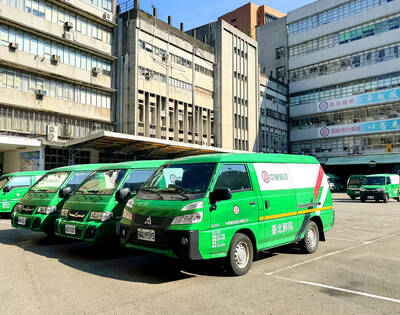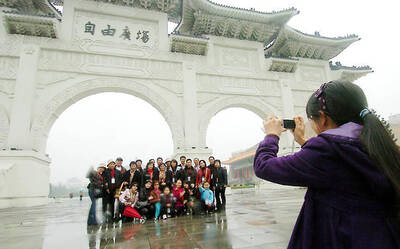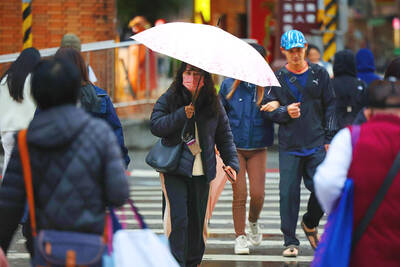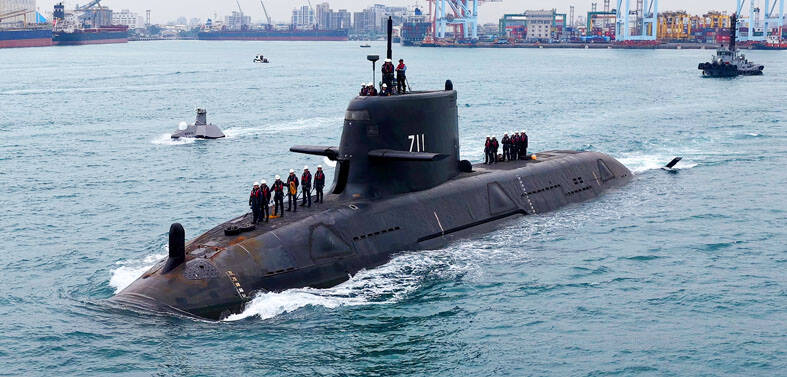“Unmanned aerial vehicles [UAV] and helicopters will play a bigger role in anti-terrorism missions in the future, both at home and abroad,” Ma Tenglong (馬騰龍), a marketing manager at the Aviation Industry Corp of China (AVIC), China’s largest aircraft manufacturer, said at the 4th China (Beijing) International Exhibition and Symposium on Police Equipment and Anti Terrorism Technology and Equipment (CIPATE) earlier this month.
Although Beijing’s interest in UAVs has been known for years, it wasn’t until the 8th China International Aviation and Aerospace Exhibition (Airshow China) in Zhuhai, Guangdong Province, in November last year that the scope of Chinese capabilities in that department was fully unveiled. In all, more than 25 models of UAVs were showcased and a good number of them had dual-use capabilities, meaning that they had both civilian and military applications.
While the development and deployment of unmanned vehicles by the Chinese military and security apparatus adds to an already complex situation in Asia, it is a perfectly natural consequence of China’s rise and Beijing is only following the example set by other modern militaries the world over.
However, what is more worrying, experts say, is that Chinese officials appear to have been impressed by, and to have learned lessons from, precedents set by the US.
“The PLA [People’s Liberation Army] has probably been the keenest watcher of the use of the latest technology by US forces,” Steve Tsang (曾銳生), director of the China Policy Institute in the School of Contemporary Chinese Studies at the University of Nottingham, told the Taipei Times. “The PLA tries to learn as much as it can from the application of new technology in the ‘battlefield’ and picks up some of the language used, too.”
Coverage on May 20 by the state-owned China Daily of the CIPATE show underscores that interest.
“In anti-terrorism operations outside China — including the recent killing of Osama bin Laden by the United States — unmanned aerial vehicles and helicopters have played an important role in reconnaissance and also carry out air-to-ground attack missions,” it said.
One of the drones on display at the CIPATE, held on May 19 through May 21, was AVIC’s “Pterodactyl,” which can be used for surveillance and reconnaissance as well as air-to-ground attack missions. Its mission time extends to 20 consecutive hours and it can operate at an altitude of 5,000m.
Also on display was a variety of domestically produced weapons systems for UAVs, reports said.
However, as Roger Cliff, an expert on the Chinese military at the Project 2049 Institute, told the Taipei Times, we should approach comments like those made by Ma with skepticism.
“AVIC [though state-owned] is not part of the Chinese military, so anything said by AVIC employees should not be construed to represent the view of China’s military or civilian security apparatus,” he said. “Ma is a marketing manager and his statements were made at an international exhibition of police and counterterrorist equipment. He is trying to promote the sales of UAVs abroad, not making an authoritative statement about how UAVs will be used in China.”
In addition, many of the systems displayed at these exhibitions are developed for export only and are never procured by China’s domestic security forces, Cliff said.
Still, it would not be surprising if Chinese military and nonmilitary forces eventually began using UAVs outside China’s territory, he said.
The Chinese, like others, appear to have embraced the notion of “extraterritoriality” in UAV use and this stems principally from the fact that their use is seen as more permissible and less controversial when they are caught or shot down over foreign territory.
“Getting caught with a UAV over another country’s territory doesn’t seem to be as provocative as sending manned spy aircraft,” Cliff said. “An Iranian UAV was shot down over Iraq a year or so ago and it was treated as a minor incident, like discovering that a foreign diplomat had been engaged in espionage or something.”
“Compare that to what happened when Gary Powers was shot down over the Soviet Union and captured,” Cliff said, referring to the May 1, 1960, shooting down of a US U-2 spy plane near Svedlovsk, in the former Soviet Union.
“China is regularly accused of violating the Line of Actual Control along the China-India border with foot patrols, so it’s hard to see how sending UAVs over disputed areas would be considered qualitatively worse. Getting caught with one over Indian territory that China doesn’t claim would undoubtedly upset New Delhi, but certainly wouldn’t be considered an act of war,” he said.
Already, the Hindu newspaper reported on May 22 on what appears to have been a UAV sighting by the Indo-Tibetan Border Police (ITBP) force on a recent patrol in the difficult high terrain along India’s disputed mountainous border with China. (The sightings by the ITBP could not be documented with certainty, given the lack of sophisticated equipment at many outposts in India’s border regions.)
Military experts regard the incident as the latest indication of China’s expanding UAV program.
Another worrying possibility emerging from China’s embrace of UAV technology is that its unmanned missions could extend from traditional border surveillance and be applied to a definition of terrorism that is far more vague than that which has regulated US operational use in places like Pakistan, Afghanistan and Yemen.
In fact, Beijing will very likely rely on UAV capability to address the so-called “three evils” of “terrorism, separatism and religious extremism,” meaning that “separatist” leaders from Xinjiang, Tibet and Taiwan could all be fair game.
Tsang said drone technology would likely apply to all such scenarios — including Taiwan.
“If there should be a military confrontation [over Taiwan], the PLA will unquestionably use all its most advanced weaponry. Drones and stealth helicopters would be used for ‘decapitation’ [attacks],” he said.
Alexander Huang (黃介正), a senior associate at the Center for Strategic and International Studies, said the utility of UAVs was not limited to “anti-terrorist” operations, but was in fact very wide in conventional military actions, from reconnaissance to decapitation.
“For China, the UAV could be a useful, lower cost, low-intensity device in the ISR [intelligence, surveillance and reconnaissance] missions as part of its A2/AD [anti-access, area-denial] strategy,” over Taiwan, Huang said.
The implication is that Chinese UAVs could soon, if they aren’t already, enter foreign airspace or international waters to conduct reconnaissance, surveillance and perhaps even targeted killings, much as the US has done in recent years.
Beyond Taiwan, the Tibetan government-in-exile could present an opportunity for UAV use by the PLA, especially if the context were to change following the recent change of leadership there.
Should newly elected Tibetan government-in-exile Prime Minister Lobsang Sangay adopt, as some predict, a more “reactionary” policy vis-a-vis the Chinese occupation of Tibet, it is very possible that at some point in the future China could deploy drones in areas along the Tibetan Plateau bordering Dharamsala, India, where the government-in-exile has been based since the Dalai Lama’s exile. During the election earlier this year, Sangay said he would move from Boston, Massachusetts, to Dharamsala if he were elected.
As China gains strength and self-confidence, it can be expected to begin exercising certain “rights” that for the past two decades have been principally a US prerogative as a result of its military supremacy. As that balance shifts, China will be the likeliest challenger of that right and by virtue of the relatively low cost and “acceptability” of deployment, UAVs could be the first expression of that challenge.
“The possible threat is not only to Taiwan, but to those forces operating along the Western Pacific,” Huang said.

SHIPS, TRAINS AND AUTOMOBILES: The ministry has announced changes to varied transportation industries taking effect soon, with a number of effects for passengers Beginning next month, the post office is canceling signature upon delivery and written inquiry services for international registered small packets in accordance with the new policy of the Universal Postal Union, the Ministry of Transportation and Communications said yesterday. The new policy does not apply to packets that are to be delivered to China, the ministry said. Senders of international registered small packets would receive a NT$10 rebate on postage if the packets are sent from Jan. 1 to March 31, it added. The ministry said that three other policies are also scheduled to take effect next month. International cruise ship operators

NUMBERS IMBALANCE: More than 4 million Taiwanese have visited China this year, while only about half a million Chinese have visited here Beijing has yet to respond to Taiwan’s requests for negotiation over matters related to the recovery of cross-strait tourism, the Tourism Administration said yesterday. Taiwan’s tourism authority issued the statement after Chinese-language daily the China Times reported yesterday that the government’s policy of banning group tours to China does not stop Taiwanese from visiting the country. As of October, more than 4.2 million had traveled to China this year, exceeding last year. Beijing estimated the number of Taiwanese tourists in China could reach 4.5 million this year. By contrast, only 500,000 Chinese tourists are expected in Taiwan, the report said. The report

Temperatures are forecast to drop steadily as a continental cold air mass moves across Taiwan, with some areas also likely to see heavy rainfall, the Central Weather Administration (CWA) said. From today through early tomorrow, a cold air mass would keep temperatures low across central and northern Taiwan, and the eastern half of Taiwan proper, with isolated brief showers forecast along Keelung’s north coast, Taipei and New Taipei City’s mountainous areas and eastern Taiwan, it said. Lows of 11°C to 15°C are forecast in central and northern Taiwan, Yilan County, and the outlying Kinmen and Lienchiang (Matsu) counties, and 14°C to 17°C

STEERING FAILURE: The first boat of its class is experiencing teething issues as it readies for acceptance by the navy, according to a recent story about rudder failure The Hai Kun (海鯤), the nation’s first locally built submarine, allegedly suffered a total failure of stern hydraulic systems during the second round of sea acceptance trials on June 26, and sailors were forced to manually operate the X-rudder to turn the submarine and return to port, news Web site Mirror Daily reported yesterday. The report said that tugboats following the Hai Kun assisted the submarine in avoiding collisions with other ships due to the X-rudder malfunctioning. At the time of the report, the submarine had completed its trials and was scheduled to begin diving and surfacing tests in shallow areas. The X-rudder,